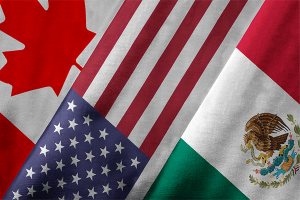 Long-awaited recognition of the impact of technology on trade in North America will come into force on July 1 when the United States-Mexico-Canada Agreement (USMCA) takes effect.
Long-awaited recognition of the impact of technology on trade in North America will come into force on July 1 when the United States-Mexico-Canada Agreement (USMCA) takes effect.
The California Chamber of Commerce supported the agreement based on an assessment that it will serve the employment, trading and environmental interests of California, the United States, Mexico and Canada, and is beneficial to the business community and society as a whole.
U.S. Trade Representative Robert Lighthizer announced the trade pact’s effective date on April 24 when he notified Congress that Canada and Mexico have taken measures necessary to comply with their commitments under the USMCA.
Following that notification to Congress, the United States became the third country to notify the other parties that it had completed its domestic procedures to implement the agreement—the final step necessary for the USMCA to enter into force.
The new USMCA website of the U.S. Department of Commerce at www.trade.gov/usmca provides key information about the agreement.
CalChamber Support
The CalChamber actively supported the creation of the USMCA, the successor to the North American Free Trade Agreement (NAFTA).
The United States, Canada and Mexico comprise more than 490 million people (6.5% of the world’s population), a $26 trillion gross domestic product (GDP) (18.3% of world GDP), and $6 trillion in trade (nearly 16% of global trade).
The objectives of the USMCA are to eliminate barriers to trade, promote conditions of fair competition, increase investment opportunities, provide adequate protection of intellectual property rights, establish effective procedures for implementing and applying the agreements and resolving disputes, and to further trilateral, regional and multilateral cooperation.
Due to California’s position as a global leader in international trade, the priorities of the USMCA are important to the CalChamber’s members and the overall economic health of the state.
Background
President Donald J. Trump announced his intent to renegotiate the NAFTA in May 2017. The negotiations started shortly thereafter, going through many rounds. In August 2018, the United States and Mexico reached a preliminary agreement, while the U.S. continued separate negotiations with Canada. In October, Canada and the United States came to an agreement right before a self-imposed deadline, reassuring the deal would remain trilateral. The pact was rebranded the United States-Mexico-Canada Agreement (USMCA).
The USMCA is a necessary modernization to NAFTA that recognizes the impacts of technology on the three countries’ economies. There are new chapters on good regulatory practices, digital trade, small and medium-sized enterprises (SMEs), the environment, and labor. In total there are 34 chapters: 10 new chapters and 24 modernized chapters.
The USMCA deal improves access to Canada’s dairy market for U.S. farmers, giving U.S. exporters an estimated additional 3.59% market share. It also provides for stronger intellectual property provisions, and tighter rules of origin for auto production, according to the Trump administration.
On June 23, 2020, Dr. Luz Maria de la Mora, Undersecretary for Foreign Trade at the Mexican Ministry of Economy, said “the USMCA brings certainty, clear rules, maintains free trade and preserves North American integration.”
Major Provisions
COVID-19
“The crisis and recovery from the COVID-19 pandemic demonstrates that now, more than ever, the United States should strive to increase manufacturing capacity and investment in North America. The USMCA’s entry into force is a landmark achievement in that effort,” U.S. Trade Representative Robert Lighthizer said in April 2020.
Mexico’s Economy Ministry said the USMCA’s implementation will “drive [economic] recovery of our country, of the North American region, after the health crisis caused by COVID-19.”
Certificate of Origin
One of the major changes as a result of this trade agreement is elimination of the NAFTA Certificate of Origin. Instead, the USMCA will replace the Certificate of Origin with a certification. This will now be similar to other free trade agreements, such as the Korean and Australian, which also use a certification. The certification will not be required for noncommercial shipments and imports valued at less than $2,500.
Customs De Minimis
The de minimis threshold sets the value of goods below which no duties or taxes are collected by customs. According to the U.S. Department of Commerce, to help make trade easier, faster, and cheaper, the following de minimis levels shipment values will be followed. Shipments up to these de minimis values will generally enter with minimal formal entry procedures.
• Canada will raise its de minimis level for North American express shipments from C$20 to C$40 for taxes. It will also provide for duty-free treatment for express shipments up to C$150.
• Mexico will continue to provide US$50 tax-free de minimis and also provide duty-free treatment for express shipments up to the equivalent level of US$117.
• The United States will maintain its de minimis level at US$800.
Auto Regulations
The three North American trading partners have wrapped up talks on uniform regulations to implement the USMCA’s rule of origin, including on autos and clears one of the most challenging issues for USMCA implementation. Officials in the United States, Mexico and Canada have been working since March to craft the regulations, which include specific formulas and information on how automakers must comply with the new rules to qualify for reduced tariffs under USMCA.
Automakers indicate that complying with the rules will require time-consuming and costly changes, made more difficult by the economic fallout from the pandemic—but the regulations offers auto companies a transition period between July 1 and the end of the year.
Labor Issues
Appointments are being made to the newly created independent Mexico labor expert board, which will monitor and evaluate whether Mexico is implementing its promised labor reforms in a timely manner.
Mexico Statistics
In the last 20 years, two-way trade in goods between Mexico and the United States increased dramatically from $81.4 billion in 1993 to $614.42 billion in 2019. Mexico has remained the United States’ second largest export market since 1995, with a total value of $256.3 billion in 2019. Mexico is the first or second largest trading partner for 27 American states.
Top export categories from the United States to Mexico included computer and electronic products, transportation equipment, petroleum and coal products, and chemicals. Each day, $1.7 billion in two-way trade of goods and services crosses the border. More than 50,000 small and medium-sized enterprises in the United States export to Mexico.
Mexico continues to be California’s No. 1 export market. California exports to Mexico totaled $27.8 billion in 2019, down from $30.7 billion in 2018. Mexico purchases 16% of all California exports.
California’s exports to Mexico are driven by computers and electronic products, which account for 21.1% of all California exports to Mexico. Other top categories included transportation equipment, non-electrical machinery, and electrical equipment, appliances and components.
Mexico FDI Statistics
U.S. foreign direct investment (FDI) into Mexico totaled $114.8 billion in 2018 and Mexican FDI into the U.S. totaled $37.2 billion in the same year. Mexican FDI into the U.S. supported 81,600 jobs, invested $82 million into research and development, and invested $1.1 billion into expanding U.S. exports. The top industry sectors for Mexican FDI in the U.S. were: food and beverages, communications, auto components, plastics, business services, and auto metals. (Select USA)
In California, the No. 14 country for FDI through foreign-owned enterprises (FOEs) is Mexico. Mexican FOEs in California provide 12,799 jobs through 488 firms amounting to $1.17 billion in wages. The top jobs by sector are: manufacturing, professional/business services, retail trade, wholesale trade, and financial activities (World Trade Center Los Angeles, Foreign Direct Investment, May 2020).
Canada Statistics
The United States and Canada enjoy the largest bilateral trade and investment relationship in the world. In 2019, two way trade in goods between Canada and the United States topped $612 billion. Exports to Canada were $292 billion, making it the largest export destination for the U.S.
Canada is California’s second largest export market, purchasing 9.6% of all California exports. In 2019, California exported more than $16.6 billion to Canada.
Computers and electronic products remained California’s largest exports, accounting for 28.6% of all California exports to Canada.
Canada FDI Statistics
Canada is the second largest source of FDI in the U.S. in 2018. FDI from Canada directly supports 726,900 jobs in the U.S. Canada invested $1 billion in research and development and $15 billion toward expanding U.S. exports. The top U.S. industry sectors that Canada FDI goes to are: software and information technology (IT) services, financial services, business services, industrial machinery, real estate, and textiles (SelectUSA).
In California, the No. 4 country for FDI through foreign-owned enterprises (FOEs) is Canada. Canadian FOEs in California provide more than 61,841 jobs through 1,583 firms amounting to $5.9 billion in wages. The top jobs by sector are: manufacturing, professional/business services, financial activities, wholesale trade and retail trade (World Trade Center Los Angeles, Foreign Direct Investment, May 2020).

